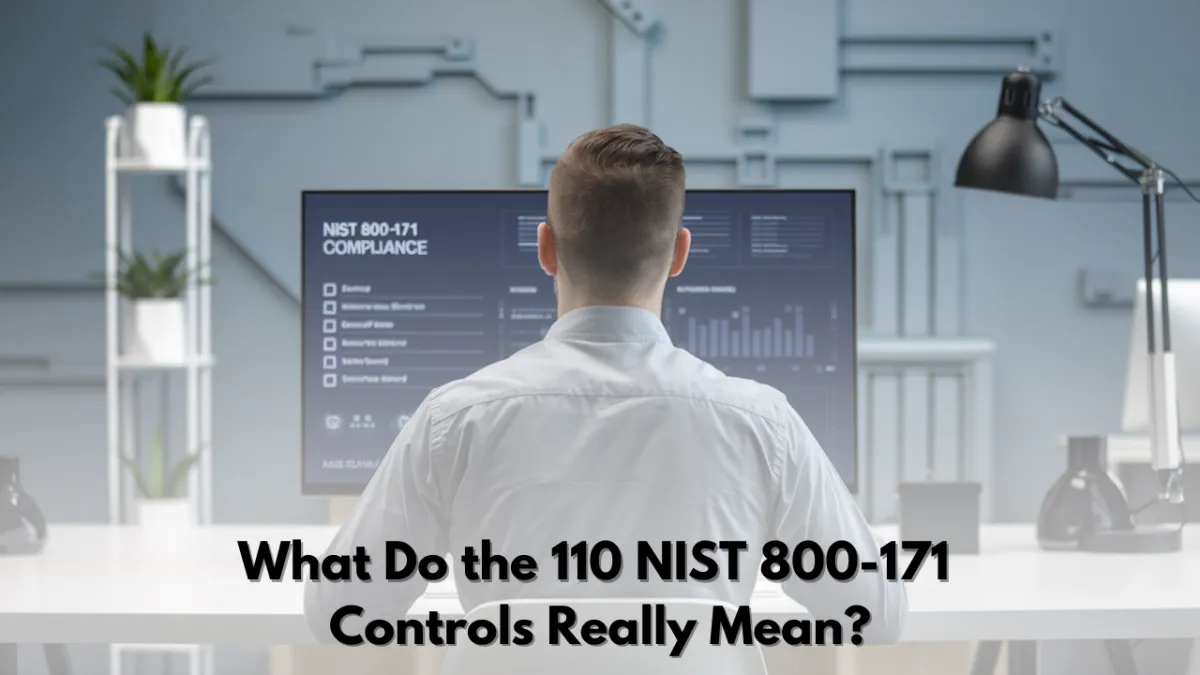
What Do the 110 NIST 800-171 Controls Really Mean?
Struggling to make sense of the 110 NIST 800-171 controls required for CMMC Level 2 compliance? You’re not alone. Most defense contractors and manufacturers feel overwhelmed when trying to interpret technical government language and apply it to their real-world environments.
In this article, we break it all down in plain English—so you can stop spinning your wheels and start getting compliant with confidence.
What Is NIST 800-171 and Why Does It Matter?
NIST SP 800-171 (Rev. 2) is the foundation for CMMC Level 2 compliance. It outlines 110 cybersecurity controls across 14 families that contractors must implement to protect Controlled Unclassified Information (CUI).
If you’re a DoD contractor or subcontractor handling CUI—or even might handle it—you’re contractually obligated under DFARS clause 252.204-7012 to implement NIST 800-171.
Your SPRS score is based on how many of these 110 controls you’ve properly implemented. And yes—the Department of Defense expects that you’ve already done the work and absorbed the cost.
Control Family Highlights (Explained in Plain English)
Here’s a breakdown of key control families that trip up most contractors—and how to tackle them without losing your mind.
Access Control
Main idea: Only the right people should have access to the right information—and nothing more.
Use individual user accounts (no shared logins)
Implement role-based permissions
Enforce least privilege access
Lock down access to CUI by person, device, and job function
Shared shop-floor accounts are one of the top reasons manufacturers fail their CMMC assessments.
Awareness & Training
Main idea: Everyone on your team must be trained on cybersecurity and CUI risks specific to their role.
Deliver role-based training
Document completion (e.g., save PDFs from DoD’s CUI training site)
Maintain audit logs showing who took what training and when
Audit & Accountability
Main idea: Log everything—and make sure no one can erase those logs.
Enable logging on servers, firewalls, switches, and endpoints
Use a SIEM system to aggregate and protect logs
Retain logs for at least 90 days (preferably 1 year)
Without proper logging, you can’t prove what happened—or didn’t happen—after an incident.
Configuration Management
Main idea: Know what your “approved” systems look like—and detect any changes.
Define and document baseline configurations for systems
Avoid vendor default settings
Track changes and verify system compliance regularly
Identification & Authentication
Main idea: Know who is logging in and make sure it’s really them.
Use strong passwords
Enforce multi-factor authentication (MFA) for CUI access, admin activity, and remote work
Avoid exceptions, even for local file servers or internal tools
Incident Response
Main idea: Be ready to detect, contain, and report cybersecurity incidents—fast.
Write and test your Incident Response Plan
Report incidents within 72 hours via the DoD’s cyber reporting portal
Secure a Medium Assurance Certificate before you need it
Treat even potential threats (like compromised email accounts) as incidents—because the DoD might.
Maintenance & Media Protection
Maintenance: Track patches, updates, and repairs.
Media Protection: Encrypt and secure CUI wherever it lives.
Patch all systems regularly—including switches, firewalls, and mobile devices
Use FIPS 140-2 validated encryption for CUI at rest and in transit
Physically secure printed documents, USB drives, and shared tools
Personnel Security & Physical Protection
Main idea: Screen your people and protect your buildings.
Perform background checks and define screening standards
Secure CUI storage areas with locks, access logs, and visitor logs
Track keys, proximity cards, and other access devices
Risk Assessment vs. Security Assessment
Risk Assessment: Identify vulnerabilities before attackers do.
Security Assessment: Confirm that your controls are still working.
Run monthly or quarterly vulnerability scans
Regularly review your System Security Plan (SSP) and associated policies
Update security settings when systems or users change
The Number One Reason Companies Fail CMMC Assessments
It’s not technical—it’s documentation.
You could implement every control perfectly, but if you don’t document it, you’ll fail. Assessors need to see:
Lists of authorized users and devices
Proof of enforcement (such as screenshots or system exports)
Policies, procedures, and audit trails that match your SSP
"You can do everything right, but if you haven’t documented it—no soup for you."
That Seinfeld reference from the episode says it all.
Do It Right, Sleep Better
Yes, 110 controls can feel overwhelming—but taken one step at a time, they’re manageable.
Implement them with intention, document everything, and revisit often. Not only will you pass your CMMC assessment—you’ll actually be protected against the kinds of threats that keep DoD leadership up at night.
